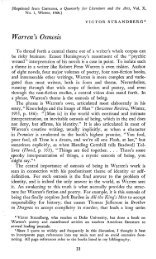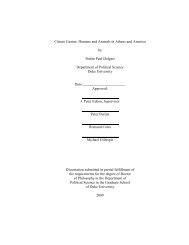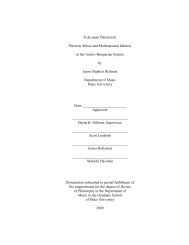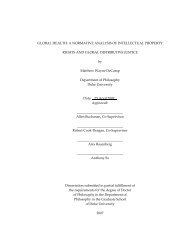View/Open - DukeSpace - Duke University
View/Open - DukeSpace - Duke University
View/Open - DukeSpace - Duke University
Create successful ePaper yourself
Turn your PDF publications into a flip-book with our unique Google optimized e-Paper software.
Homosexuality as a discrete sexual identity simply did not exist per se, and it was only with the<br />
influence of Western ideology that the term was named and incorporated into the Chinese<br />
lexicon in the early 1900s (Brown 2008; Chou 1997).<br />
Before translation, euphemisms were used to refer to same-sex attraction, often<br />
originating from classical Chinese texts that allude to homoeroticism (Zhang 2001; 2008). 21 In<br />
Passions of the Cut Sleeve: The Male Homosexual Tradition in China (1992), Bret Hinsch<br />
traces the history of such euphemisms that are still recognized in contemporary Chinese society,<br />
including “the cut sleeve” ( 断 袖 duanxiu), “the split peach” ( 分 桃 fentao), and “male practice”<br />
( 男 风 nanfeng). 22 Though identified as the first serious English language treatment of same-sex<br />
behaviors in pre-modern China, reviewers have criticized this book for being “unidimensional”<br />
and “deceptive” in its conclusion that China’s twentieth-century homophobia resulted solely<br />
from the adoption of Western sexual discourse (Dikötter 1992, 170; Williams 1994, 87).<br />
Charlotte Furth, Chinese historian, also questioned Hinsch’s passive acceptance of the Western<br />
liberationist dialectic of tolerance versus repression without questioning whether its application<br />
would be appropriate in the Chinese context (1991, 912). Because of this, Hinsch’s book<br />
overlooks the complexity of China’s Imperial past to provide a reductive conclusion that<br />
twentieth-century China’s homophobia resulted from the adoption of Western sexual discourse.<br />
After the Cultural Revolution in the 1980s, scholars began investigating China’s<br />
changing attitudes towards homosexuality, but most of these works assert that the evolution of a<br />
stigmatized queer identity resulted from China’s exposure to Western influences (Lau and Ng<br />
1989; Tsai 1987). Samshasha’s History of Homosexuality in China (1984) is a case in point: the<br />
book traces China’s history of homoerotic love from the Zhou dynasty (11 th century BC to 221<br />
21 A list of notable classical Chinese novels with homoerotic content is included in Appendix IV.<br />
22 For a list of other euphemisms, refer to Appendix V.<br />
Introduction | 18
















